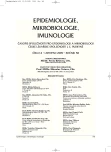Antibiotic Resistance and Biofilm Formation in Pseudomonas aeruginosa Strains Isolated from Patients with Urinary Tract Infections
Authors:
L. Černohorská; P. Sláviková
Authors place of work:
Mikrobiologický ústav, Brno
Published in the journal:
Epidemiol. Mikrobiol. Imunol. 58, 2009, č. 4, s. 154-157
Summary
Altogether 118 Pseudomonas aeruginosa strains isolated from urine of patients with urinary tract infection were tested by the disk diffusion method for susceptibility to ciprofloxacin, ofloxacin, gentamicin, amikacin, colistin, meropenem, imipenem, piperacillin/tazobactam and ceftazidime. All strains were also screened for biofilm formation using a modified Christensen method.
Eighty-eight, i.e. 74.6 %, of the tested strains were resistant to ofloxacin, 86 (72.9 %) to ciprofloxacin and 70 (59.3 %) to gentamicin. Forty strains (33.9 %) were resistant to imipenem, 42 strains (35.6 %) to meropenem, 14 strains (11.9 %) to amikacin, 2 strains (1.7 %) to colistin, 35 strains (29.7 %) to piperacillin/tazobactam and 41 strains (34.7 %) to ceftazidime.
Co-resistance to ofloxacin, ciprofloxacin and gentamicin was detected in 67 strains (56.8 %) while 12 strains (10.2 %) were resistant to most tested antibiotics, with the exception of amikacin and colistin.
Biofilm formation was found in 41 strains (34.7 %), more precisely in 23 of 46 inpatient strains and 18 of 72 outpatient strains. Eight (66.6 %) of 12 polyresistant strains were biofilm producers.
Key words:
P. aeruginosa – fluoroquinolones – gentamicin – aminoglycosides – urinary tract infection – biofilm.
Zdroje
1. Christensen, G. D., Simpson, W. A., Bisno, A. L., Beachey, E. H. Adherence of slime-producing strains of Staphylococcus epidermidis to smooth surfaces. Infect Immun, 1982, 37, 318-326.
2. Christensen, G. D., Simpson, W. A., Younger, J. J., Baddour, L. M. et al. Adherence of coagulase-negative Staphylococci to plastic tissue culture plates: a quantitative model for the adherence of staphylococci to medical devices. J Clin Microbiol, 1985, 22, 996-1006.
3. Costerton, J.W., Stewart, P. S., Geenberg, E. P. Bacterial biofilms: A common cause of persistent infections. Science, 1999, 284, 1318-1322.
4. Černohorská, L., Votava, M. Determination of Minimal Regrowth Concentration (MRC) in clinical isolates of various biofilm-forming bacteria. Folia Microbiol, 2004, 49, 75-78.
5. Darouiche, R. O. Prevention of infections associated with vascular catheters. Intensive Med, 1999, 36, 349-354.
6. Hoyle, B. D., Costerton, J. W. Bacterial resistance to antibiotics: the role of biofilms. Progr Drug Res, 1991, 37, 91-105.
7. Lu, T. K., Collins, J. J. Dispersing biofilms with engineered enzymatic bacteriophage. Proc Natl Acad Sci USA, 2007, 104, 11191-11202.
8. Monden, K., Ando, E., Iida, M., Kumon, H. Role of fosfomycin in synergistic combination with ofloxacin against Pseudomonas aeruginosa growing in a biofilm. J Infect Chemother, 2002, 8, 218-226.
9. Monzón, M., Oteiza, C., Leiva, J., Amorena, B. Synergy of different antibiotic combinations in biofilms of Staphylococcus epidermidis. J Antimicrob Chemother, 2001, 48, 793-801.
10. Raad, I., Hanna, H. Intravascular catheters impregnated with antimicrobial agents: a milestone in the prevention of bloodstream infections. Support Care Cancer, 1999, 7, 386-390.
11. Song, W., Woo, L., Kim, J. S., Lee, K. M. In vitro activity of β-lactams in combination with other antimicrobial agents against resistant strains of Pseudomonas aeruginosa. Int J Antimicrob Agents, 2003, 21, 8-12.
12. Stewart, P. S., Costerton, J. W. Antibiotic resistance of bacteria in biofilms. Lancet, 2001, 358, 135-138.
13. Stone, J. H., Gabriel, M. M., Ahearn, D.G. Adherence of Pseudomonas aeruginosa to inanimate polymers including biomaterials. J Ind Microbiol Biotechnol, 1999, 23, 713-717.
14. Tolker-Nielsen, T., Brinch, U. C., Ragas, P. C., Andersen, J. B. et al. Development and dynamics of Pseudomonas sp. biofilms. J Bacteriol, 2000, 182, 6482-6489.
15. Trautner, B. W., Hull, R. A., Darouiche, R. O. Colicins prevent colonization of urinary catheters. J Antimicrob Chemother, 2005, 56, 413-415.
Štítky
Hygiena a epidemiologie Infekční lékařství MikrobiologieČlánek vyšel v časopise
Epidemiologie, mikrobiologie, imunologie

2009 Číslo 4
- Stillova choroba: vzácné a závažné systémové onemocnění
- Diagnostický algoritmus při podezření na syndrom periodické horečky
- Perorální antivirotika jako vysoce efektivní nástroj prevence hospitalizací kvůli COVID-19 − otázky a odpovědi pro praxi
- Prokalcitonin: marker vhodný pro diagnostiku sepse i hodnocení antimikrobiální léčby
Nejčtenější v tomto čísle
- Pseudomonas aeruginosa, její rezistence k vybraným antibiotikům a tvorba biofilmu u kmenů izolovaných od pacientů s infekcí močových cest
- Dynamika výskytu Creutzfeldtovej -Jakobovej choroby na Slovensku v rokoch 1975-2008
- Sérové protilátky proti endomýziu (AEA) v diagnostickom algoritme celiakie
- Přínos stanovení core antigenu v diagnostice infekce hepatitidy C testem firmy Abbott Laboratories
